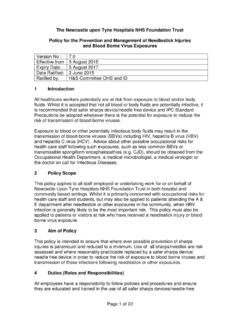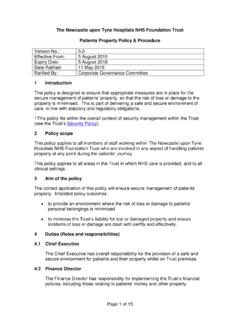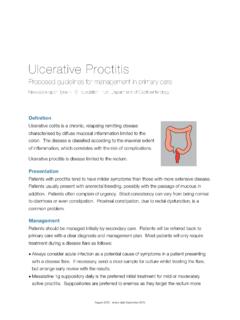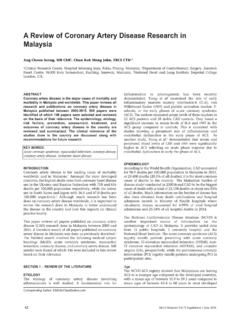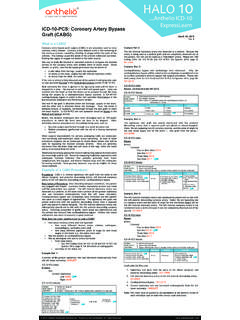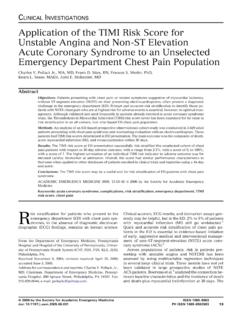Transcription of Recovering from coronary angioplasty and stent insertion
1 Recovering from coronary angioplasty and stent insertion A new start 1. This booklet has been produced to help you to recover from your coronary angioplasty or stent insertion as quickly and safely as possible. It is for your relatives or carers too. It is suitable for adults of all ages. The information should help with some of your questions. There is advice about what you can do to make a speedy recovery. Simple exercises to do in the first few weeks after your angioplasty are described. There is information about diet, your medicines, and when you can start doing certain activities again. There is a section about stress and how to deal with it. The booklet has information about cardiac rehabilitation and support groups in your area, and useful addresses and telephone numbers. Please take time to look at this. We hope that you find it helpful. Members of the cardiothoracic service at Freeman Hospital produced this booklet in 2005.
2 Review date: 2007. With many thanks to the local cardiac rehabilitation teams, members of the cardiology and cardiothoracic surgical services, as well as the many individuals who have had coronary angioplasty and contributed to, or commented on this information. We are grateful to Simon Thorp for the artwork. 2. Contents Your Heart 3. About angioplasty 5. Exercise after angioplasty 7. Activities and tasks: When can I ? 13. Your medicines 15. Managing stress and tension 21. Sex is good for your heart 26. Returning to work 27. Maintaining a healthy heart: 28. Healthy eating and drinking 28. Stopping smoking 31. High blood pressure 32. Diabetes 33. Cardiac rehabilitation programmes 34. Cardiac Support groups 35. Newcastle Leisure Facilities 37. Contact numbers and useful addresses 38. Diary and monitoring sheets 39. 3. Your Heart Your heart is a pump made of muscle. It works non-stop throughout your life pumping blood around your body.
3 Your blood carries oxygen from the air you breathe, and food from your stomach and gut to supply your body with all it needs to work. Your heart needs oxygen and food too. It gets these from its own blood supply the coronary arteries. What is coronary heart disease ? Usually there is nothing wrong with your heart . indeed, it is the strongest muscle you have. Your heart trouble has been caused by problems in your coronary arteries. Parts of your coronary arteries have become narrowed over time. This is sometimes known as hardening of the arteries or arteriosclerosis. It is very common. Most people have some narrowing of their arteries as they grow older. When the coronary arteries become narrow the blood supply to your heart is not so good. When your body needs more blood usually when you exert yourself your heart has to pump harder. It needs more blood itself. The heart muscle hurts when it does not have the supply of blood it needs this is angina pain.
4 This pain usually gets better with rest and with nitrate drugs like GTN (see page 18). Emotional upset or extremes of temperature can also cause angina pain. A heart attack happens when part of the coronary arteries becomes blocked. One part of the heart muscle does not get its blood supply and is damaged. Resting or taking GTN does not relieve pain caused by a heart attack. 4. Why do the coronary arteries become narrowed? Over a long time (perhaps starting when you were a teenager), a fatty layer builds up on the inside of your arteries. This layer gets thicker and thicker. Some parts of your arteries may become very narrow. Then it is difficult for your blood to get through. Usually there are only a few parts of your coronary arteries where there is this narrowing. Sometimes your arteries deal with this local problem by growing new blood vessels in that part of your heart.
5 There is a danger of narrowed arteries becoming blocked by clotted blood sticking to the artery wall. This picture below shows a bit of coronary artery becoming narrower and narrower as it becomes blocked up with a fatty layer. Risk factors for heart disease include high levels of cholesterol in your blood, smoking, lack of exercise, and high blood pressure. These factors speed up the narrowing of the coronary arteries. There is more information about the risk factors in the section about maintaining a healthy heart (page 28). 5. What can I do about coronary artery disease ? There is a lot that can be done to help to treat this problem. coronary artery bypass graft surgery creates a bypass route around the narrowed artery or arteries to improve the blood flow to the heart. angioplasty (stretching an artery open), and putting in stents are ways to reopen the arteries that have narrowed.
6 Stents There is medicine that helps to control coronary artery disease , (Page 15). You can do a lot to reduce the risk of narrowing arteries and to stay well after this procedure. Take a look at the section on maintaining a healthy heart for ideas about staying well (page 28). About angioplasty angioplasty is widely used to treat blockages or narrowing in the coronary arteries. The aims are to help you return to a fuller and more active life, and to reduce your risk of future heart problems. A small cut is needed in the groin or arm. Local anaesthetic is used to reduce any discomfort. A small hollow tube on a wire called a catheter is guided into an artery and along to your heart. Using X-ray pictures as guidance, the catheter is positioned where the narrowing is. A balloon is inflated to open the artery and improve blood flow. A stent (a metal tube to hold open an artery ).
7 May be left in larger arteries. The catheter with its deflated balloon is then removed. The procedure may be quite simple and completed in 20 minutes or so. Sometimes it can be technically difficult and take much longer. 6. Recovery immediately after the procedure involves resting. If the catheter was inserted in your groin, then you need to keep fairly still for several hours to allow the insertion site to heal. After angioplasty or stent insertion Most people do not need to be in hospital for long after this treatment. It is normal to go home the same or following day. Your heart is hopefully working much better straight after the treatment now that it has a better blood supply. You may find that you can immediately start to do much more than before. Don't forget that your level of fitness before the procedure will affect how much you can do. You may need to build up your activities gradually to increase your fitness.
8 Most people do make a straightforward recovery. However you may notice some after-effects of this treatment. Here are some ideas about what you can do about these. The good news is that these will usually clear up with time. Bruising: It is normal to have bruising around the puncture site. You may discover a hard lump around the wound, especially if your wound is in your groin. This should resolve over time. Contact your GP surgery if you notice that the area has become inflamed and red, or if you have any concerns about the healing in this area. Take paracetamol for pain relief if necessary. Constipation: This may happen because of your tablets or because you are less active than normal. Eating plenty of foods high in fibre like fruit, vegetables and grains, drinking plenty of water and exercising may help. Your GP or practice nurse can advise you about dealing with this.
9 Chest Pain: You may experience mild chest pain or ache following angioplasty and stent insertion , especially if several stents were put in place. This can take several weeks to settle. Tingling and numbness: Some people notice tingling or numbness in their leg. This is due to the local anaesthetic and will settle after a few days. 7. angioplasty is an effective treatment for most people. However, a few people may not get a long-lasting benefit. The coronary arteries may start to narrow again. Use your GTN spray if you think you are experiencing angina (see page 18). Contact your general practitioner if this continues. Don't forget that there is a range of treatments for angina. Exercise after angioplasty or stent insertion One of the great benefits of these heart treatments is being able to do more. Taking exercise will: Make you feel good Help your heart recover Help you to sleep better Build up your fitness Lower your blood pressure Help you have a healthy weight Lower your cholesterol levels Help your heart stay well Spending most of your time lying or sitting down will not help your heart recover and could cause problems.
10 Don't be put off if you have arthritis or another physical problem indeed, exercise may help. When should I start to exercise? Try to start as soon as you are settled back at home certainly within the first few days. You should have no angina and more energy after the procedure. However, you may feel stiff around your wound. Try to balance activity with rest. What should I do? Walking is a great way of exercising you can go at your own pace, and walk as far as you like. 8. Choose a route that allows you to rest if you want to a wall or bench to sit on. Bit by bit build up the length of your walk. As you feel fitter, try walking up a slight slope or walk more briskly. You might aim to be walking 1 2 miles (about 30 to 60 minutes) or even 3 to 5 miles by six weeks after your treatment. However, everyone is different plan your exercise to suit you and your recovery. How can I tell if I am exercising at the right level?





